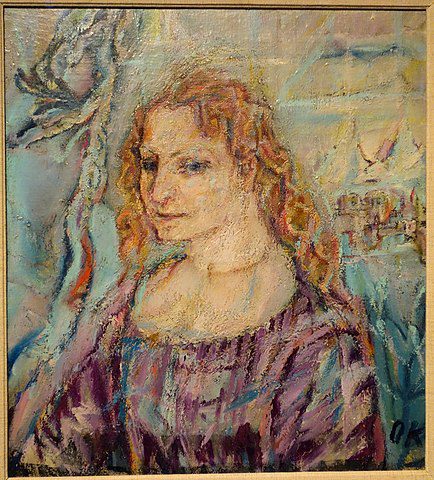
Alma Mahler and Oskar Kokoschka shared a relationship marked by intense passion and drama. Their love story stands as one of the most fascinating and tumultuous in art history. Alma Mahler was the widow of the famous composer Gustav Mahler, and she was known for her beauty, intelligence, and artistic talent. Oskar Kokoschka was an expressionist painter and writer who had a reputation for being intense and passionate. When they met in 1912, their relationship quickly became a whirlwind of love, creativity, and conflict.
The Beginnings of an Artistic Affair
Alma and Oskar’s relationship began in Vienna, a city known for its vibrant cultural scene. Alma, mourning the recent loss of her husband Gustav Mahler, found herself drawn to Oskar’s intense personality. Oskar admired Alma’s intelligence and beauty. Their mutual attraction quickly developed into a deep emotional bond. They often spent their days discussing art, music, and literature, which fueled their creativity.
Despite their connection, the relationship was not without its challenges. Alma was a widow with two young daughters and was still dealing with grief. Meanwhile, Oskar’s intense emotions often led to jealousy and possessiveness. These differences led to frequent arguments and misunderstandings. However, the couple’s shared passion for art often helped them reconcile after disagreements.
Oskar’s paintings during this period often featured Alma as his muse. He created some of his most famous works while they were together. Alma inspired many of his paintings, and his artistic output soared during their relationship. This artistic collaboration strengthened their bond, even as they struggled with their personal issues.
Alma and Oskar’s relationship also faced external pressures. Society had certain expectations, especially for a woman like Alma, who was part of Vienna’s elite. Their unconventional relationship sometimes scandalized the public, but Alma and Oskar remained committed to each other for the time being.
A Relationship in Turmoil
As their relationship progressed, Alma and Oskar began to experience more turmoil. Oskar’s jealousy became a significant issue, and he often suspected Alma of infidelity. These suspicions led to heated arguments, which sometimes escalated into physical confrontations. Despite this, they both found it difficult to walk away from their intense connection.
Oskar’s possessiveness also affected Alma’s social life. He often tried to control who she could see and where she could go. Alma, a fiercely independent woman, struggled against these restrictions. This tension created a rift between them, leading to further conflict.
Their differing personalities also contributed to their relationship troubles. Alma was sociable and enjoyed being in the company of others. Oskar, on the other hand, preferred solitude and could be moody and reclusive. This fundamental difference often led to misunderstandings and disagreements.
Despite these challenges, Alma and Oskar continued to be drawn to each other. Their shared passion for art and intellectual pursuits kept them connected, even as their personal struggles threatened to tear them apart. However, the constant turmoil took a toll on both of them.
Eventually, the strain became too much for Alma, and she decided to end the relationship. The breakup was painful for both of them, but it marked the end of their tumultuous romance. Though they parted ways, their love story continued to impact their lives and work.
The Artistic Legacy of Their Love
Alma and Oskar’s relationship had a lasting impact on their artistic work. Oskar’s paintings from this period reflect the intensity of his emotions and his passion for Alma. His use of color and form became more expressive, capturing the depth of his feelings for her. Some of his most famous works, including “The Bride of the Wind,” were inspired by their relationship.
Alma also found inspiration in her relationship with Oskar. Her experiences with him influenced her musical compositions and her work as a patron of the arts. Although she did not compose much during their time together, the emotional depth of her music reflects the passion and turmoil of their relationship.
Their relationship also left a mark on the broader art world. Oskar’s expressionist style influenced many artists, and his paintings of Alma remain iconic pieces of art history. Alma’s influence as a muse and her role in Vienna’s cultural scene also contributed to the legacy of their love.
Despite the challenges they faced, Alma and Oskar’s relationship demonstrated the power of art to express complex emotions. Their connection inspired them to create works that continue to resonate with audiences today. The artistic legacy of their love is a testament to the enduring power of passion and creativity.
Life After the Breakup
After their breakup, both Alma and Oskar struggled to move on. Oskar found it difficult to accept the end of their relationship, and he continued to be haunted by memories of Alma. He often used her as a subject in his paintings, attempting to capture the essence of their love.
Alma, on the other hand, sought solace in her work and her children. She focused on her role as a patron of the arts, supporting composers and musicians. Although she had other relationships, none matched the intensity of her connection with Oskar. The breakup left a lasting impact on her life and work.
In an attempt to cope with his loss, Oskar commissioned a life-sized doll of Alma. This unusual creation allowed him to feel as though she was still present in his life. The doll became a fixture in his studio, and he often used it as a model for his paintings.
Although the breakup was painful, it ultimately allowed both Alma and Oskar to grow as individuals. They each pursued their artistic passions with renewed focus and determination. Their time together had a profound impact on their lives and work, even after they parted ways.
The Doll: A Symbol of Obsession
One of the most famous aspects of Oskar’s post-breakup life was his creation of a life-sized doll of Alma. This unusual artifact symbolized his continued obsession with her. The doll was an eerily lifelike representation of Alma, complete with clothing and accessories that she might have worn.
Oskar commissioned a dollmaker to create the doll, and he treated it as if it were a living person. He often posed the doll in his studio, using it as a model for his paintings. The presence of the doll allowed Oskar to maintain a connection to Alma, even after their relationship ended.
The doll became a symbol of Oskar’s inability to let go of his feelings for Alma. It also represented the intensity and complexity of their relationship. Although the doll was a source of comfort for Oskar, it also highlighted his struggle to move on from their love.
Despite its unusual nature, the doll remains an important part of Oskar’s artistic legacy. It serves as a reminder of the powerful emotions that drove his work and the impact of his relationship with Alma. The doll’s existence continues to fascinate and intrigue art historians and audiences alike.
Alma’s Life After Oskar
Following her breakup with Oskar, Alma continued to live a vibrant and fulfilling life. She remained a prominent figure in Vienna’s cultural scene, supporting artists and musicians. Her contributions to the arts earned her a reputation as a respected patron and influencer.
Alma’s personal life also continued to be eventful. She married Franz Werfel, a writer and playwright, and they had a son together. Although her relationship with Werfel was less tumultuous than her romance with Oskar, it was still marked by passion and creativity. Alma’s experiences with Oskar undoubtedly influenced her future relationships.
In addition to her role as a patron, Alma continued to compose music. Although her output was limited, her compositions reflect her emotional depth and artistic talent. Her music remains an important part of her legacy, showcasing her contributions to the world of classical music.
Alma’s life after Oskar was filled with both challenges and triumphs. She navigated the complexities of her personal and professional life with grace and determination. Her ability to move forward and continue to make an impact on the art world speaks to her resilience and strength.
Oskar’s Artistic Evolution
Oskar Kokoschka’s artistic journey did not end with his breakup with Alma. Instead, he continued to evolve as an artist, exploring new styles and techniques. His work became more focused and refined, reflecting his growth and maturity as an artist.
During the years following his relationship with Alma, Oskar traveled extensively. He sought inspiration from different cultures and landscapes, which influenced his work. His paintings from this period often feature vibrant colors and dynamic compositions, showcasing his mastery of expressionist techniques.
Oskar also became more involved in the political and social issues of his time. He used his art to comment on the events around him, creating works that were both visually striking and thought-provoking. This new focus allowed him to channel his emotions into meaningful and impactful art.
Although Oskar’s relationship with Alma had a lasting impact on his work, it did not define his entire career. He continued to push the boundaries of expressionism, creating a diverse and impressive body of work. His artistic evolution demonstrates his resilience and ability to adapt to the changing world around him.
Conclusion: A Love That Shaped Their Lives
The passionate and tumultuous relationship between Alma Mahler and Oskar Kokoschka left an indelible mark on their lives and work. Their love story was marked by intense emotions, artistic collaboration, and personal challenges. Despite their differences and the difficulties they faced, their connection inspired them to create some of their most memorable and impactful work.
Alma and Oskar’s relationship serves as a reminder of the power of love and passion to fuel creativity. Their shared experiences and artistic pursuits helped shape their legacies, leaving a lasting impact on the art world. While their love story was not without its struggles, it ultimately contributed to the richness and depth of their artistic contributions.
Both Alma and Oskar continued to lead remarkable lives after their relationship ended. They each pursued their passions with renewed focus and determination, leaving behind a legacy that continues to inspire and captivate audiences today. The love between Alma Mahler and Oskar Kokoschka remains a testament to the enduring power of passion and creativity in the world of art.




